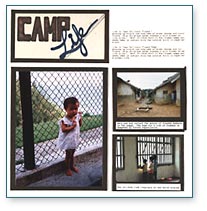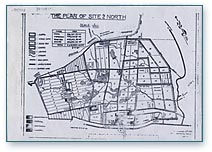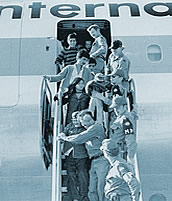Continued from page 1
Refugee Camps in Asia
Temporary makeshift refugee camps were set up in Hong Kong, Indonesia, Macao, Malaysia, the Philippines, and Thailand, referred to as countries of first asylum, to accommodate the refugees. Conditions varied in each of these relocation processing centers. Some were overcrowded and dangerous prison-like settings. Camp officials differed too; many were helpful, while others were corrupt and exploited the refugee population both financially and sexually. Some camps lacked adequate food, sanitation, and health care facilities. Some refugees stayed in the camps for a short period of time, while others spent many idle years waiting to find sponsors before they could be relocated. In some camps services such as English language classes or social adjustment courses were provided to “Westernize” the refugees and prepare them for the resettlement process. 
Some refugees were allowed to leave the camps daily to find employment in nearby areas. Countries such as Australia, Canada, China, and France offered permanent asylum. The United States accepted the largest number of refugees. In many cases over time, family members sponsored refugees and became directly responsible for their resettlement. The U.S. government passed the Refugee Act of 1980 which defined who qualified as a refugee, set up the Office of Refugee Resettlement, allowed for an annual allotment of 50,000 refugees beyond regular immigration quotas, and clarified the federal government’s responsibilities for providing assistance to refugees.
International Refugee Programs
To resolve the refugee crisis, in 1979 the United Nations High Commissioner for Refugees helped to set up an agreement, referred to as the Orderly Departure Program (ODP), between the Socialist Republic of Vietnam and 26 participating countries. This program created a legal and organized means to facilitate migration. Refugees in camps were given permission to leave and were flown to the U.S. Preference was given to those who had relatives already in the U.S. who could sponsor them.
 In 1989 the Humanitarian Operation (HO) Program, officially named the Special Release Reeducation Center Detainee Resettlement Program, was created to allow former South Vietnamese military personnel or civilian employees who were allied with the U.S. to enter the country. These individuals had faced harsh conditions after the communist government seized control. They were imprisoned in “re-education camps,” where they did hard labor, some for over a decade. Their family members were mistreated and discriminated against as well. Those who qualified for the HO Program were allowed to immigrate with their families and were provided services similar to those with “refugee” status. In 1989 the Humanitarian Operation (HO) Program, officially named the Special Release Reeducation Center Detainee Resettlement Program, was created to allow former South Vietnamese military personnel or civilian employees who were allied with the U.S. to enter the country. These individuals had faced harsh conditions after the communist government seized control. They were imprisoned in “re-education camps,” where they did hard labor, some for over a decade. Their family members were mistreated and discriminated against as well. Those who qualified for the HO Program were allowed to immigrate with their families and were provided services similar to those with “refugee” status.
|



 In 1989 the Humanitarian Operation (HO) Program, officially named the Special Release Reeducation Center Detainee Resettlement Program, was created to allow former South Vietnamese military personnel or civilian employees who were allied with the U.S. to enter the country. These individuals had faced harsh conditions after the communist government seized control. They were imprisoned in “re-education camps,” where they did hard labor, some for over a decade. Their family members were mistreated and discriminated against as well. Those who qualified for the HO Program were allowed to immigrate with their families and were provided services similar to those with “refugee” status.
In 1989 the Humanitarian Operation (HO) Program, officially named the Special Release Reeducation Center Detainee Resettlement Program, was created to allow former South Vietnamese military personnel or civilian employees who were allied with the U.S. to enter the country. These individuals had faced harsh conditions after the communist government seized control. They were imprisoned in “re-education camps,” where they did hard labor, some for over a decade. Their family members were mistreated and discriminated against as well. Those who qualified for the HO Program were allowed to immigrate with their families and were provided services similar to those with “refugee” status.